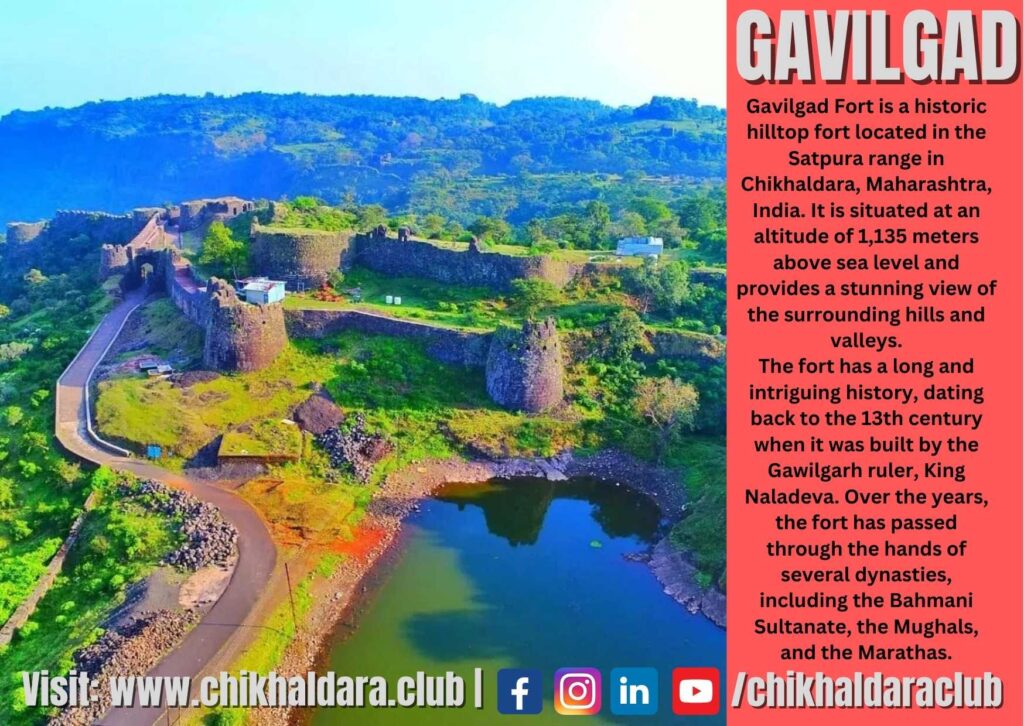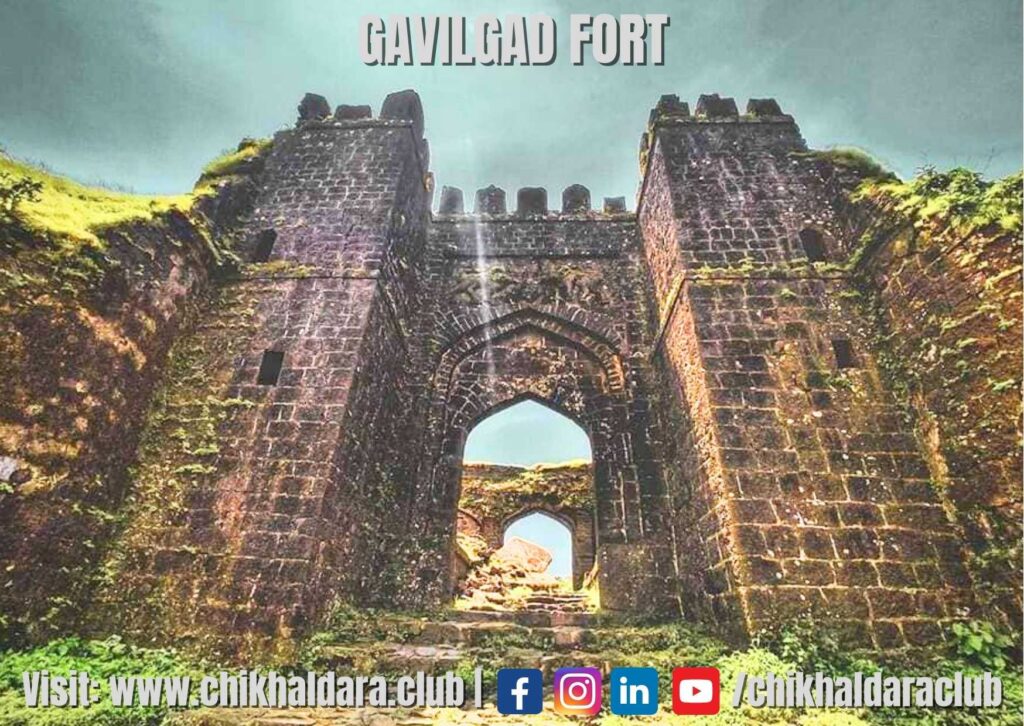Table of Contents
History of Gavilgad Fort
Gavilgad fort located on Satpura range at about 1103 meters above sea level is situated in Chikhaldara a tehsil place in Amravati district of Maharashtra. The fort was built by Bahamani Sultan Ahmad Shah in 1425-26. The fort functioned as capital of Berar at different times. It passed through many hands after the Bahamani kingdom split up, starting with the Imadshahi Dynasty in 1488, the Nizamshahi Dynasty in 1574, with the Mughals 1600, the Marathas in 1744 before it finally fell to the East India Company in 1803 AD. The strategic importance of Gavilgad lay in the fact that it was in a position to control the Melghat region.
The fort is situated on top of a hill and is surrounded by dense forests, making it a popular tourist destination. The history of Gavilgad Fort dates back to the 14th century, when it was built by the Gond rulers. The Gonds were a tribe that ruled over the region for several centuries and were known for their bravery and military skills. In the 16th century, the fort came under the control of the Bahmani Sultanate, a powerful Muslim dynasty that ruled over parts of South India. Later, it was captured by the Mughal Empire and then by the Maratha Empire, who used it as a military base.
During the British colonial period, the fort was used as a prison and a garrison. After Indian independence in 1947, the fort was taken over by the Indian government and is now a protected monument under the Archaeological Survey of India. Today, Gavilgad Fort is a popular tourist destination and attracts thousands of visitors every year. The fort offers stunning views of the surrounding landscape and is a testament to the rich history and culture of the region.

Architecture of Gavilgad Fort
The architecture of Gavilgad Fort located in Chikhaldara is a blend of different styles that reflect the different periods of its history. The fort is built on a hill and is spread over a vast area of land. The Gavilgad Fort is made up of Basalt Rocks. The main entrance to the fort is through a gate known as the ‘Mahadarwaja‘, which is a massive gateway built using large blocks of stone. The fort is divided into three parts, the upper fort, the middle fort, and the lower fort. The upper fort is the highest point of the fort and is the most well-preserved part of the structure. The middle fort contains several residential buildings and storage areas, while the lower fort has several temples and water tanks.
The walls of the fort are built using locally sourced stone and are several meters thick. They are fortified with bastions and watchtowers, which were used for defense and surveillance purposes. The fort also has several underground passages and secret chambers that were used by the rulers to escape during times of war.
One of the notable features of the fort is the presence of several water tanks, which were used to store water for the inhabitants of the fort during times of siege. The tanks are built using stone and are designed to collect rainwater. The architecture of Gavilgad Fort is a testament to the engineering and architectural skills of the people who built it. It reflects the different styles and influences of the different rulers who controlled the fort over the centuries, making it a unique and fascinating historical monument.

Things to see in Gavilgad Fort
- Fort Gates: The Fort has 12 gates, namely : Delhi Darwaza, Keechak Darwaza, Veerbhan Darwaza, Fateh Darwaza etc.
- Fort Lakes: Fort also has many small lakes inside the fort: Dev Talav, Paras Talav etc. It is believed to have been used as a source of drinking water by the soldiers and residents of the fort during the ancient times. The lake is surrounded by lush greenery and provides a serene environment for visitors to relax and enjoy the natural beauty of the fort.
- Choti Masjid: was built by Nizam Shahi in 1577-78, which is small mosques inside the Gavilgad fort. Choti Masjid is a small mosque located inside the Gavilgad Fort in Maharashtra, India. It is believed to have been built during the reign of the Bahmani Sultanate in the 14th century. The mosque is built in the typical style of Islamic architecture with a central prayer hall and a domed roof. The prayer hall has a mihrab (a niche indicating the direction of Mecca) and a minbar (a raised platform for the Imam to deliver the sermon). The walls of the mosque are adorned with intricate carvings and calligraphy.
- Rani Mahal: There is one six dome structured Rani Mahal inside the fort, which has beautiful architecture. The palace is located on a hilltop and is surrounded by lush greenery and scenic views. It has two minarets and small lake front of it. This place is also known as Jami Masjid. Despite its historical significance, Rani Mahal is currently in a state of ruin and requires restoration and conservation efforts. However, it remains a popular tourist destination and a symbol of the rich cultural heritage of the region.
- Jauhar Kund is a historical site located within the Gavilgad Fort in Maharashtra, India. It is believed to have been used for the ritual of Jauhar, which was an act of self-immolation committed by women to avoid capture, enslavement, and dishonor at the hands of invading armies.
- Hathi Khana is a large rectangular building that was used as a stable for elephants during the reign of the Maratha empire. The structure is made of stone and has several small rooms that were used to house elephants. The roof of the building is flat and made of stone slabs. There are also several large doors on the sides of the building through which the elephants could enter and exit.

Things to Carry During Gavilgad Fort Visit
If you are planning a visit to the Gavilgad Fort in Maharashtra, India, there are several things you may want to consider bringing with you. Gavilgad Fort is spread over huge area, you need to be physically fit to trek to its various parts. Here are some suggestions:
- Comfortable Clothing: Wear comfortable and breathable clothes that are appropriate for the weather conditions. Avoid wearing heavy or restrictive clothing that may make it difficult to climb stairs or walk on uneven terrain.
- Good Shoes: Wear sturdy and comfortable shoes that are suitable for hiking or walking on rocky terrain. Avoid wearing flip flops or sandals that may cause blisters or injuries.
- Sunscreen and Sunglasses: Protect your skin and eyes from the sun’s harmful UV rays by wearing sunscreen and sunglasses. This is required during summer season, when sun heat is unbearable.
- Water Bottle and Snacks: Carry a water bottle and some snacks to stay hydrated and energized during your visit. The fort is located on a hilltop, and there may not be any shops or restaurants nearby.
- Camera: Bring a camera or a smartphone to capture the stunning views and historical sites inside the fort.
- Umbrella: It rains heavily during monsoon season, if you don’t want to get soaked in rain water, you can consider taking umbrella with you.
Remember to respect the historical sites and natural environment inside the fort and follow any rules or regulations that are in place to preserve them.

Precautions while Visiting Gavilgad Fort
If you are planning to visit the Gavilgad Fort in Maharashtra, India, there are a few precautions you should take to ensure a safe and enjoyable trip:
- Wear Comfortable Clothing and Shoes: The fort is located on a hilltop, and there are several stairs and uneven paths to climb. Wear comfortable clothing and sturdy shoes that are appropriate for hiking or walking on rocky terrain.
- Carry Enough Water and Snacks: The fort is located in a remote area, and there may not be any shops or restaurants nearby. Carry enough water and snacks to stay hydrated and energized during your visit.
- Be Careful While Climbing Stairs: Some of the stairs inside the fort may be steep and narrow. Take your time while climbing and be careful not to slip or fall.
- Respect the Historical Sites: The fort is home to several historical sites and monuments. Respect these sites and do not damage or deface them in any way.
- Beware of Monkeys: The fort is home to a large population of monkeys. While they may seem harmless, they can be aggressive and may try to snatch food or other belongings. Avoid feeding or interacting with the monkeys.
- Carry a First Aid Kit: It’s always a good idea to carry a small first aid kit with basic supplies like band-aids, antiseptic lotion, and pain relievers in case of emergencies.
- Follow Safety Instructions: If there are any safety instructions or warnings posted inside the fort, follow them carefully to avoid accidents or injuries.
By taking these precautions, you can have a safe and enjoyable visit to the Gavilgad Fort.
Frequently Asked Questions | FAQs
Who built Gavilgad Fort ?
The fort was built by Bahamani Sultan Ahmad Shah in 1425-26.
What entry ticket fee at Gavilgad Fort ?
Rs 25 per person, entry ticket is charged by Archaeological Survey of India.
Is car parking available at Gavilgad Fort ?
There is huge parking space available for vehicle parking before main entrance gate, near ticket counter.


Pingback: Chikhaldara Hill Station : 3 Days Travelogue by Vaibhav Lokhande - chikhaldara Club